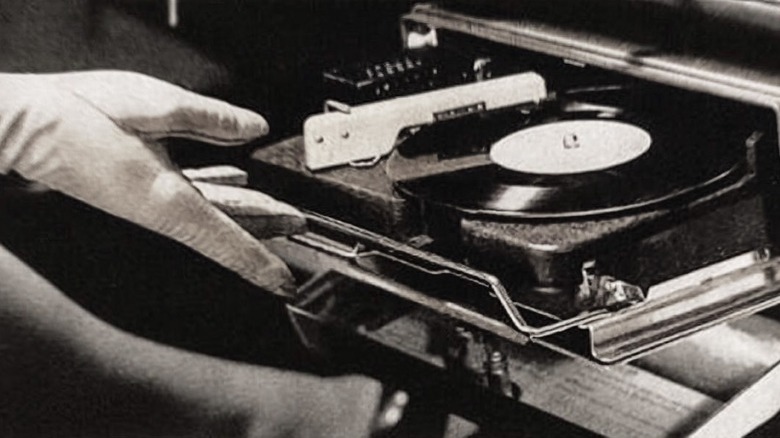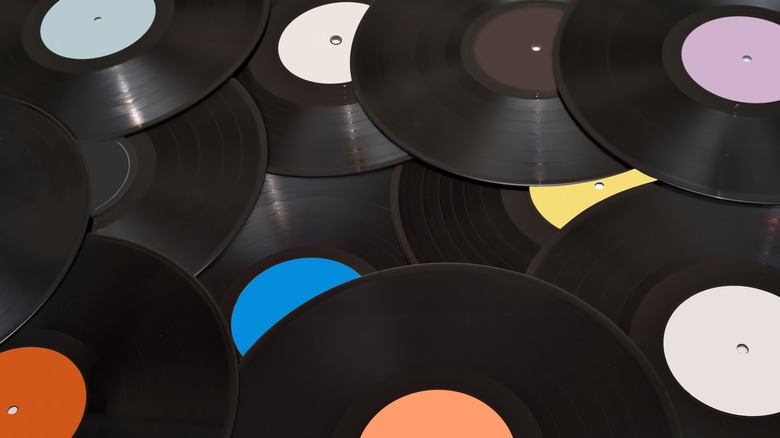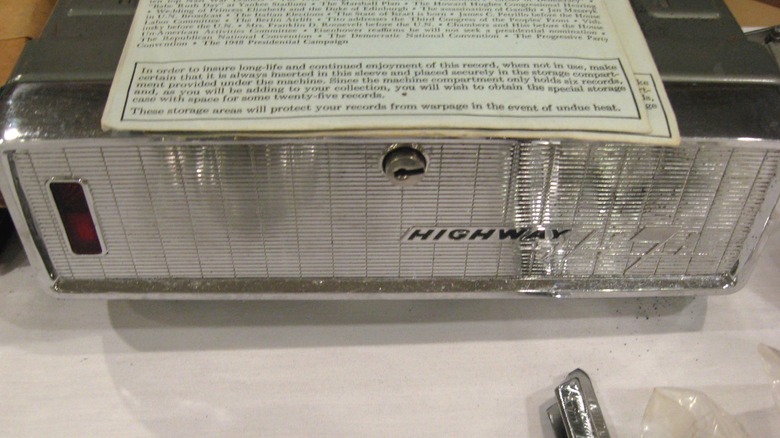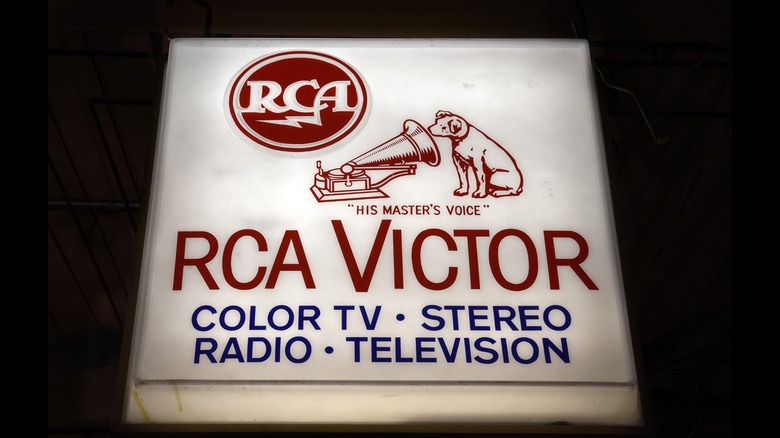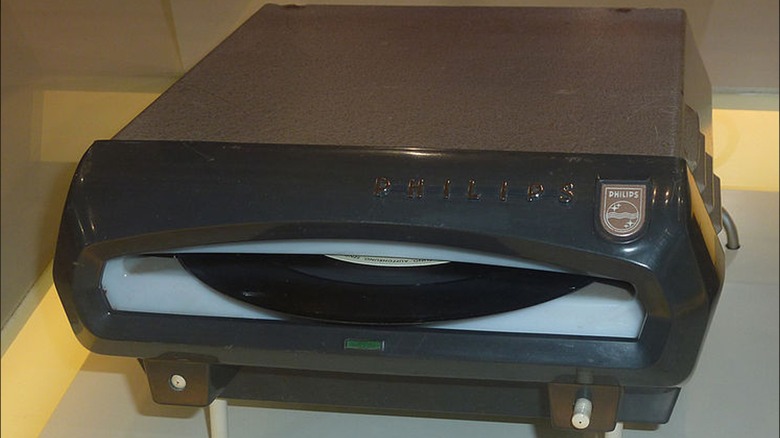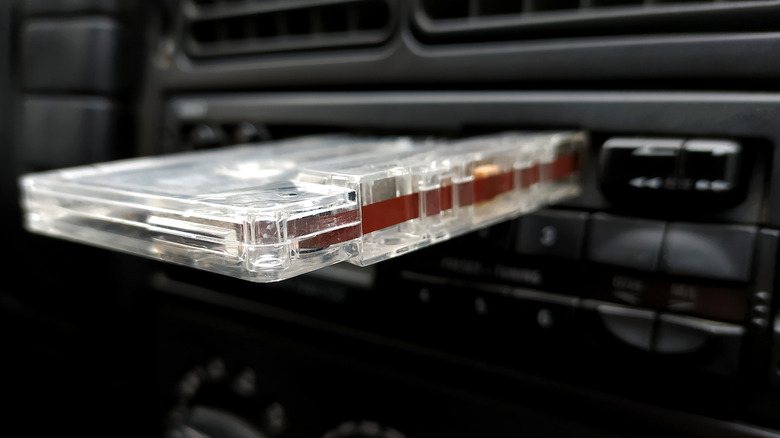Vinyl On Wheels: The Brief History Of In-Car Record Players
Nowadays, buying and listening to music on vinyl is a choice — albeit an incredibly popular choice, with vinyl records outselling CDs by a significant margin in the years since 2020. Of course, there wasn't always much of a choice to be made.
In the first few decades after World War II, buying music on vinyl wasn't just a cool thing to do, nor was it the preserve of audiophiles seeking superior sound quality – vinyl was simply the only game in town. If you wanted to listen to the latest hits at home in the 1950s, you were buying records or nothing at all. Until tape-based formats started becoming more popular (and accessible) in the 1960s, vinyl was essentially the only game in town for anyone who wanted to listen to the music of their choosing. That applied to in-car entertainment, too.
Yes, you read right — for a short period in the 1950s and early 1960s, car owners who wanted entertainment on the road without the annoyances of radio could listen to vinyl records courtesy of in-car record players from the likes of Chrysler, RCA Victor, and Norelco. Sound wacky? You bet. Let's dive into the history of this short-lived form of in-car entertainment to appreciate just how convenient our Apple CarPlay and Android Auto head units really are.
For the record
Disc-based music first emerged in the late 1880s, when German-born inventor Emil Berliner came up with the idea of storing sound on a flat disc on which the stylus traveled horizontally. Berliner's invention would become the dominant format for recorded music by the 1910s, with the recording industry eventually settling on a rotational speed of 78 rpm for these records in 1925. These early records only held between three to five minutes of music and were notoriously brittle due to being made out of shellac.
These downsides likely motivated Columbia Records to research a new format, which it debuted in 1948. This new 12- and 10-inch disc had much smaller grooves and ran at 33 1/3 rpm, allowing it to hold much more music, with Columbia's first-ever long-playing (LP) record boasting around 23 minutes of music on each side. Unfortunately for post-war consumers, RCA Victor wasn't on board with Columbia's LP and launched 45-rpm, seven-inch discs in 1949. The two formats weren't interchangeable, unlike on the best modern turntables, and the major-label backing for each meant that Columbia artists weren't available on RCA Victor's 45 rpm disks and vice versa.
RCA's smaller disc became the preferred format for singles, while the Columbia LP ruled the roost for full-length albums. This eventually changed things for the better, at least for consumers, when RCA Victor entered the 33 rpm market in 1950, while Columbia began marketing its own 45-rpm offerings a year later.
My way or the Highway Hi-Fi
While the converging vinyl market of the 1950s looked good for consumers, things still weren't great for in-car entertainment. Twelve-inch records were large and rather unwieldy, while seven-inch 45s only held around 10 minutes of music at best. One took up a lot of space, while the other required constant attention to keep the music going — neither of which was ideal in a car.
Enter CBS employee Peter Goldmark. Goldmark, one of the individuals who helped develop the 33 1/3 rpm LP, came up with an in-car record player called the Highway Hi-Fi, which debuted in Chrysler vehicles for the 1956 model year. Goldmark bypassed the issues with 12- and seven-inch records by introducing a proprietary format that used seven-inch discs playing at a much slower 16 2/3 rpm, allowing for up to an hour of music per side.
This combined the easy handling of 45s with a running time far exceeding that of even the longest 33-rpm album. While it sounded great on paper, the Highway Hi-Fi wasn't without its downsides. For one, the Highway Hi-Fi chewed through needles, which cost owners $2.50 each — nearly $32 in today's money — to replace. Secondly, the proprietary format meant that you couldn't just play the records you already had: owners had to buy dedicated Highway Hi-Fi records, and there were only ever 42 advertised.
The Highway Hi-Fi continued into 1957 in cars like the Chrysler New Yorker and Saratoga but was gone by 1958.
[Image by Bill McChesney via Wikimedia Commons | Cropped and scaled | CC BY 2.0]
Slight return
The Highway Hi-Fi's short-lived and unceremonious two-year run in Chrysler cars signaled the end of Columbia's attempt to offer vinyl-based in-car entertainment. However, Chrysler hadn't given up entirely, as just two years later, it would partner with RCA Victor for the RCA Victor Auto Victrola.
Developed by Chrysler and RCA Victor engineers and introduced for 1960 Plymouth and DeSoto cars, the Auto Victrola took a radically different approach from the Highway Hi-Fi. Instead of asking owners to invest in a new format with a limited selection of titles, RCA opted to use the already existing (and incredibly popular) 45-rpm seven-inch record in its in-car player — but with a twist.
RCA's gambit was to increase playing time simply by stacking 14 seven-inch records on top of each other, with the Auto Victrola changing between them to keep the music going hands-free. RCA claimed up to two hours of playtime with a fully loaded Auto Victrola, ensuring parity with Columbia's Highway Hi-Fi. This wasn't new technology, though, as RCA already had a 14-record player for home use, and it's entirely possible that its engineers reused the basic tech for the in-car Victrola.
Perhaps unsurprisingly, the Auto Victrola didn't fare much better than Columbia's Highway Hi-Fi. It was only available for two years before disappearing from catalogs in 1962. Coincidentally, DeSoto didn't make it into 1962 either, although we don't think iffy in-car entertainment had anything to do with the downward spiral of the DeSoto.
A new challenger appears
At around the same time that RCA Victor's Auto Victrola was struggling to gain traction, Philips Norelco debuted its take on the in-car record player. Named the Auto Mignon, Philips' offering was distinctly inferior to the RCA competition and paled in comparison even to the Highway Hi-Fi from five years before.
Unlike its supposed rivals, the Auto Mignon didn't rely on a proprietary format or record stacking to achieve extended playtimes. In fact, it dispensed with the idea of extended playtime altogether, accommodating only one seven-inch record and requiring the driver — or a willing passenger — to swap records constantly to keep the music going. It was at least a slot-loading player allowing for quick record changes, but that was scant comfort compared to the RCA unit's set-and-forget two-hour experience.
The Auto Mignon first emerged in Europe in 1960 and eventually made its way to the U.S., with Consumer Reports getting its hands on one in 1961. Despite Consumer Reports praising its playback capabilities even in rough conditions, the Auto Mignon didn't seem to catch on. We're not sure how long Philips made the Auto Mignon, but it's unlikely to have lasted very long — especially as Philips had something a lot more interesting up its sleeve that it would debut later that same decade.
[Image by Bobo Boom via Flickr | Cropped and scaled | CC BY 2.0]
Oh, mama, can this really be the end
The RCA Victor and Philips Norelco offerings were the last major attempts to bring the at-home listening experience into the car, but not necessarily because they were bad ideas. Instead, the event that sounded the death knell for in-car record players was the emergence of tape-based music in the form of the compact cassette and eight-track cartridge.
The compact cassette was a Philips invention, while the eight-track was born out of a collaboration between Ampex Magnetic Company, RCA Records, and Learjet. Both formats began eating into vinyl's market share when they launched in the mid-1960s and would continue to do so for the rest of the decade.
Ford Motor Company was the first company to offer an in-car eight-track player, giving buyers of the 1966 Lincoln, Ford Thunderbird, and Ford Mustang the option of a Stereo-sonic Tape System. The option proved popular with Lincoln Continental buyers in particular, and one out of every four Continental buyers opted for an eight-track tape player. Chrysler and General Motors followed suit soon after and, by the end of 1970, over 10 million tape decks had been installed in cars.
Philips introduced the first-ever in-car compact cassette player, the Type RN582, in 1968, and the rest, as they say, is history. Cassette went on to dominate the 1980s — and is having a big resurgence after falling out of popularity in the 2000s — while in-car entertainment continued down its inevitable path toward modern-day convenience.
